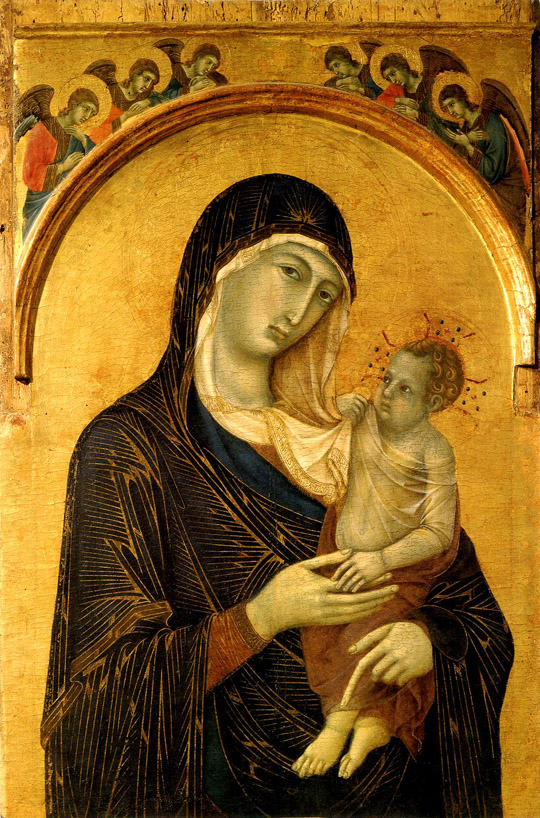Solemnity of the Immaculate Conception
Dec 8th, 2009 | By Bryan Cross | Category: Blog PostsToday is the Solemnity of the Immaculate Conception, in which we celebrate the conception of the Blessed Virgin Mary, who “from the first instance of her conception, by a singular grace and privilege granted by Almighty God, in view of the merits of Jesus Christ, the Savior of the human race, was preserved free from all stain of original sin.”1 This doctrine cannot rightly be understood, without understanding how and why Mary is the Second Eve.

Madonna and Child with Angels
Duccio di Buoninsegna (1300-1305)
Eve, by her disobedience, became the mother of all the dying. Mary, by her obedience, became the Mother of all the living, i.e. those living with the supernatural and eternal Life of God. If Mary had been conceived in original sin, she would have been the Serpent’s ally and at enmity with God like the first Eve. But God declared in the Garden that “the woman” would be at enmity with the Serpent, and thus the Church came to understand that Mary was preserved from original sin even from the first moment of her conception.
In my opinion, the best available book showing how the Church came to understand more deeply Mary’s role as the Second Eve, is Luigi Gambero’s Mary and the Fathers of the Church: The Blessed Virgin in Patristic Thought. And the best lecture I have heard on this subject was given recently by Professor Lawrence Feingold (Ave Maria University) to the Association of Hebrew Catholics. To listen to that lecture, click on the ‘play’ button directly below.
[podcast]https://hebrewca.ipower.com/SoundFiles/S5L09MaryNewEveImmaculateConception.mp3[/podcast]
To listen to the Q&A following the lecture, press play directly below:
[podcast]https://hebrewca.ipower.com/SoundFiles/S5L09MaryNewEveImmaculateConceptionQ.mp3[/podcast]
Download the mp3s for the lecture and the Q&A here.
In the first part of his lecture Professor Feingold speaks briefly about the Catholic conception of the development of doctrine, and how Mary herself provides the model for understanding the Church’s ever-deepening understanding of the deposit of faith. Then he shows how Scripture itself points to Mary as the New Eve, and how the early Church Fathers recognized and developed this doctrine of Mary as the New Eve, all holding her to be without sin. He carefully explains how the developing understanding of Mary as the New Eve gradually unveiled the doctrine of the Immaculate Conception.
In the second part of his lecture he examines the later Church Fathers. From the sixth century on in the East, three Marian feasts were celebrated: the Annunciation on March 25, the Nativity of Our Lady on September 8, and the Dormition commemorating Mary’s holy death on August 15. In this part of his lecture Professor Feingold presents a summary of the Mariology of the Eastern Fathers after Nicea. Then he discusses the theological debate concerning the Immaculate Conception in the Latin West, as that led into the time of the Scholastics. He explains why theologians such as St. Bernard, St. Thomas, and St. Bonaventure denied the Immaculate Conception, and how Bl. Duns Scotus resolved the problem by showing how it was more fitting for Christ to save His Mother through the merits of His Passion by preventing her from being deprived of sanctifying grace even at the first moment of her existence. Eventually in 1477 the feast of the Immaculate Conception was made a feast for the universal Church, and in 1708 it became a holy day of obligation in the universal Church, though it had already been a holy day of obligation for centuries in the East. Then in 1854 Pope Pius IX defined it as dogma with the solemn bull, Ineffabilis Deus.


Thanks for this post… And for the Hebrew Catholic plug :)
A wonderful explanation for those who want to understand “Mary”. As Our Lord, Jesus Christ, is called The King of Kings, The Lamb of God, The Savior of The World, The Son of David, and many more, so is The Blessed Virgin.
This will be helpful in explaining to my protestant family how Mary, the mother of Jesus, was The New Eve, etc. I’ve heard Dr. Feingold speak before and he is excellent. Does he say that Mary represents The Virgin Daughter of Zion? I guess I’ll just have to listen :-)
Thanks again, Bryan and blessings to you and your family during this time of waiting in joyful anticipation – Advent!
PAX,
Teri
I love this picture! I love how the baby Jesus is clutching her veil. Her left index finger seems to be pointing to something, what is it?
This verse struck me today like it never has before. Luke 1:43:
43And whence is this to me, that the mother of my Lord should come to me?
[…] talking about this stuff. Today is the Solemnity of the Immaculate Conception, in which we celebrate the conception of the […]
I also recommend Jaroslav Pelikan’s book “Mary Through the Centuries.”